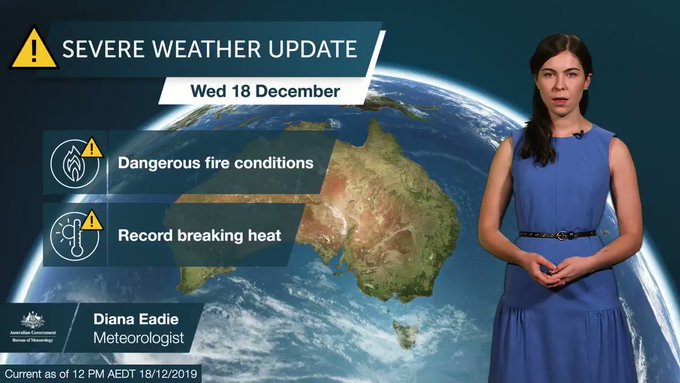Tuesday’s average maximum 0f 40.9C was Australia’s hottest ever and follows the driest and second warmest spring on record
Australia has just experienced its hottest day on record and its worst spring on record for dangerous bushfire weather, according to data released by the Bureau of Meteorology.
Preliminary analysis suggested that Tuesday was the hottest day on record for Australia, with an average maximum across the country of 40.9C. The temperature beat the previous 40.3C set on 7 January 2013, in a record going back to 1910.
Confirming the unprecedented nature of the current devastating fire season, the bureau has also found that 95% of Australia experienced fire danger weather that was well above average.
Above average temperatures, high winds, severe drought and the driest spring on record combined to bring dangerous conditions to many parts of the country.
In a special climate statement, the bureau said that by September most of the east of the continent was “primed for high fire danger ratings”, leading to hundreds of homes being lost in New South Wales.
September to November had been the driest, and second warmest, spring on record.
Fire danger
The bureau uses a tool known as the forest fire danger index (FFDI) to assess the risk of bushfire, combining temperature, wind, humidity, fuel and an assessment of drought to deliver an overall rating. The FFDI record goes back to 1950.
When the bureau added all the fire ratings together, they found this “accumulated FFDI” was the highest on record across the continent.
Daily high fire danger ratings had also reached record levels in regions in every state and territory.
North-east NSW had an average score of 25 or above – in the “very high” FFDI category – for 21 days, beating the previous highest spring count of 11 days in 2002. The average number of spring days with very high fire risk in the region is just two.
NSW RFS confirmed on Wednesday that 768 homes had been lost and almost 65000 saved during the current fire season, which still has many weeks to run.
 Bureau of Meteorology, Australia
Bureau of Meteorology, Australia✔@BOM_au
Preliminary results suggest that the 17th December was Australia’s hottest day on record at 40.9 ºC, with the average maximum across the country as a whole, exceeding the previous record of 40.3 ºC on the 7th January 2013. http://ow.ly/cEwS50xCLFh
A December heatwave starting Wednesday could also break temperature records across South Australia, Victoria and NSW, the bureau has said.
Former fire chiefs and emergency services leaders said on Tuesday they would convene their own national bushfire summit, saying climate change was forcing a rethink on how Australia should prepare for and fight bushfires.
On Monday, 22 health and medical groups called on the federal and NSW governments to respond to the “public health emergency” caused by the smoke haze from the NSW fires.
Guardian Australia has revealed that since August 2019, the fires in NSW and Queensland have emitted 250 million tonnes of carbon dioxide – almost half the country’s entire annual carbon footprint.
… the Guardian will not stay quiet. This is our pledge: we will continue to give global heating, wildlife extinction and pollution the urgent attention and prominence they demand. The Guardian recognises the climate emergency as the defining issue of our times.
You’ve read 7 articles in the last two months. We chose a different approach: to keep Guardian journalism open for all. We don’t have a paywall because we believe everyone deserves access to factual information, regardless of where they live or what they can afford to pay.
Our editorial independence means we are free to investigate and challenge inaction by those in power. We will inform our readers about threats to the environment based on scientific facts, not driven by commercial or political interests. And we have made several important changes to our style guide to ensure the language we use accurately reflects the environmental catastrophe.
The Guardian believes that the problems we face on the climate crisis are systemic and that fundamental societal change is needed. We will keep reporting on the efforts of individuals and communities around the world who are fearlessly taking a stand for future generations and the preservation of human life on earth. We want their stories to inspire hope. We will also report back on our own progress as an organisation, as we take important steps to address our impact on the environment.
Credit: Source Link
